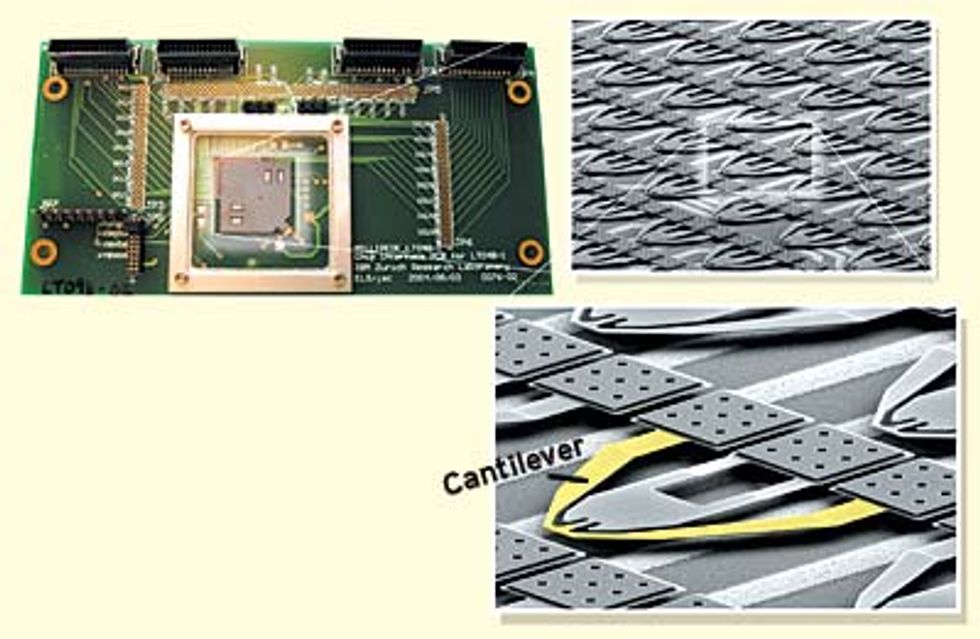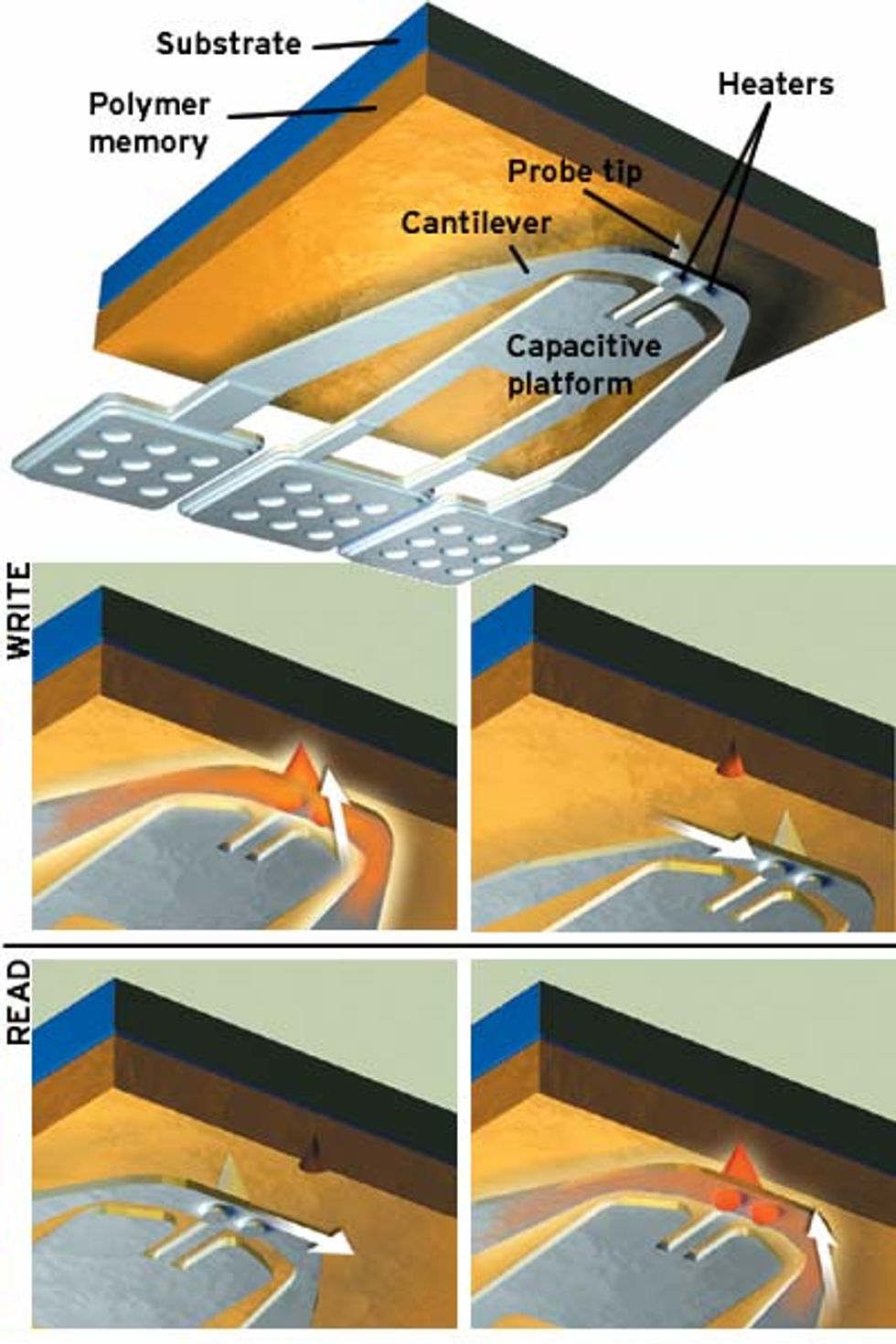The Race to the Bottom
Can a polymath engineer beat IBM to market with the world's first consumer nano device?
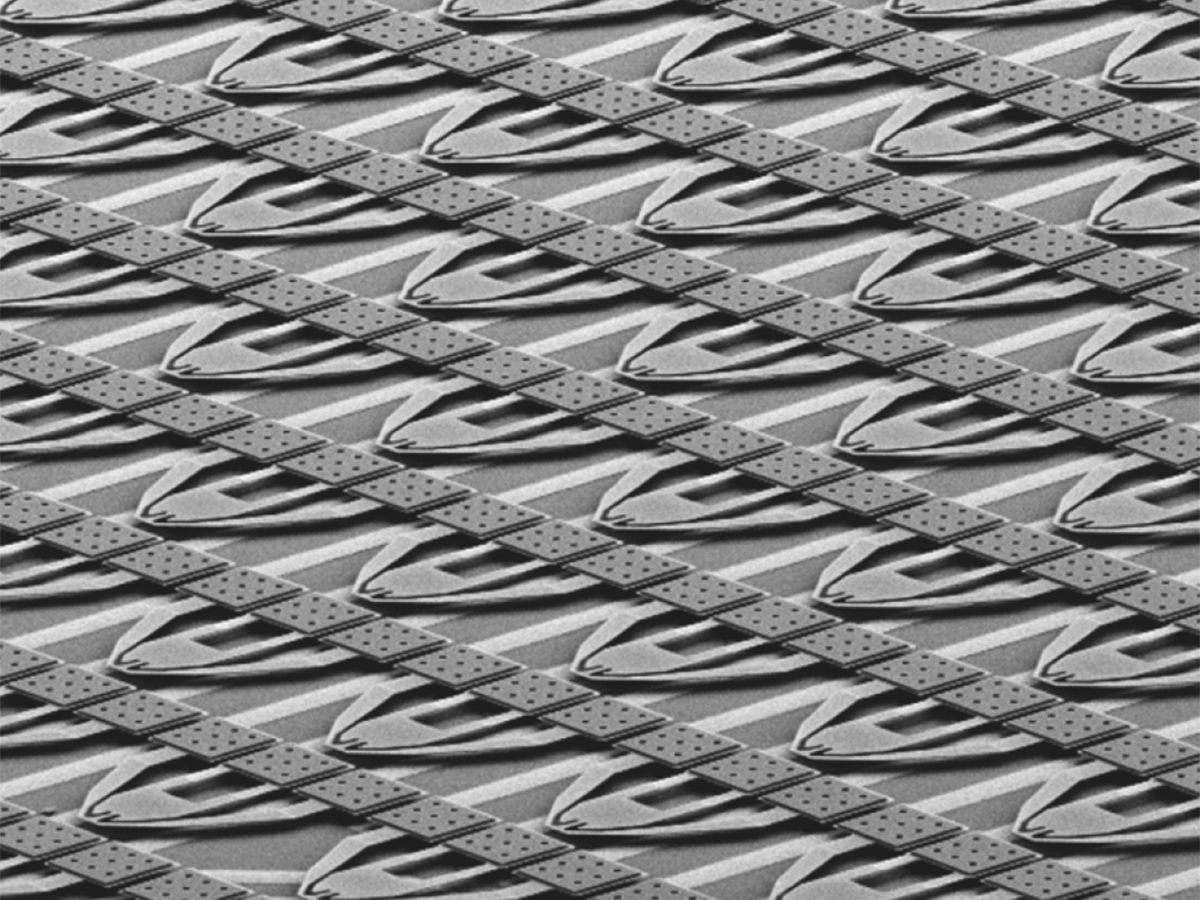
Contrary to entrenched popular lore, earthshaking inventions hardly ever spring fully formed from the overheated brain of a single supergenius. They blow in with the intellectual zeitgeist, products of an era when many researchers know something big is about to happen and pursue it with the intensity of sharks feasting on a fresh seal carcass.
Thus, for every Alexander Graham Bell, there was an Elisha Gray; for every Thomas Edison, a Joseph Swan. And someday, if nanotechnology makes good on its promise to revolutionize human society, Gerd Binnig will have his Tom Rust. Or, perhaps, Tom Rust will have his Gerd Binnig.
Binnig, a Nobel laureate in physics and a star in IBM Corp.’s metamorphosing research apparatus, and Rust, a self-taught engineer who founded a start-up with a staff of 16, are in many ways nanotechnology’s least likely pair of combatants. They’re a couple of mavericks who, after 20 years of hunches, feverish experimentation, and perpetually mutating designs, are now on the brink of what could be nanotechnology’s first truly big commercial breakthrough: a memory system that could up the ante in the high-stakes struggle to keep data storage on a par with the pitiless pace of advances in consumer and computing electronics.
With longstanding promises of infinitesimal machines that manipulate matter literally atom by atom, advances in nanotechnology and microelectromechanical systems (MEMS) have been the stuff of countless research theses, business plans (mostly failed ones), and science fiction plots. After all, when the atom is your building block, materials of astounding properties, vastly faster and smaller electronics, and even synthetic human tissues are all within the realm of possibility.
So far, though, nanotech and MEMS have delivered much more breathless hype than broadly transformative technology. And that’s why the emerging nano- and MEMS-based data-storage application, which is called probe storage, has corporate researchers in a feeding frenzy. Packing Brobdingnagian memories in Lilliputian packages, probe drives are prime candidates to combine the low cost, high capacity, and random-access features of ordinary magnetic hard-disk drives with the low power draw, high data rate, small size, and nonvolatility of solid-state flash memories. In so doing, they could fuel burgeoning markets for super-high-capacity personal media players and pocketable computers with storage far exceeding that of today’s desktop models.
Demonstrations in the last few years by companies like IBM and Rust’s company, Nanochip Inc., in Fremont, Calif., show that probe drives can cram a terabit (128 gigabytes) into each square inch of memory media. (The industry’s standard measure for the density of bits that can be packed onto storage media is expressed in the English unit of inches.) For contrast, conventional magnetic hard drives, such as the one-inch microdrives found in products like the Apple iPod, can at best achieve only 250 to 300 gigabits per square inch. They are subject to the superparamagnetic limit, the density above which magnetic domains are so small that thermal fluctuations interfere with the medium’s ability to hold steady magnetization and, therefore, data. The huge capacity of probe systems translates into as many as 125 hours of DVD-quality video recording time, which would allow digital video camera makers to dump those bulky, power-sucking tape drives and shrink camcorders to fit in shirt pockets. Media players that now rely on DVD drives could store 25 movies on a chip and lose the drive altogether.
Developers of probe drives expect that the first generation of devices—which could be on the market as soon as January 2007—will compete directly with flash memory, now a staple in digital cameras, cellphones, USB key-chain memories, and MP3 players. Flash was a US $4.8 billion market in 2004, according to Gartner Inc. in Stamford, Conn.—and it’s growing, to $8.4 billion by 2008, Gartner predicts.
With a potential market worth billions, IBM and Nanochip have plenty of competition in probe drives. Seagate and Samsung are pouring millions into probe-storage R&D Hewlett-Packard, Hitachi, and Philips have all explored probe drives over the last few years.
Nevertheless, IBM and Nanochip are unquestionably in the front rank, having worked on the technology longer than any other companies and having logged major prototype milestones in the last year. In recent years IBM has been focusing more and more of its R&D on software that helps corporate computer systems monitor and administer themselves automatically and on services to optimize business processes for corporate clients. Its probe-storage project, called Millipede, is something of a throwback to the days when hardware ruled in Big Blue’s labs. Since IBM no longer has the facilities to manufacture Millipede devices, the company is considering looking for a partner to commercialize it, according to Karin Vey, communications manager at IBM’s Zurich Research Laboratory (ZRL), where the Millipede project is based. Vey emphasizes that IBM has not yet made a final decision about Millipede’s commercial future and that “it is conceivable that the Millipede technology will not be sold as a product by itself but will find its way into other products.” But to knowledgeable outsiders, Millipede seems to be a technology looking for a home, or at least a licensee.
For the privately held Nanochip, meanwhile, the challenge is that of any start-up: getting technology to market before funding runs out. So it isn’t much of a stretch to say that the near-term future of one of the most promising memory technologies in decades is in the hands of a colossal multinational that isn’t sure what it wants to do with it and a tiny start-up that is burning its venture capital with each passing day.
Supposedly stupendous memory technologies have come and gone before without ever ruffling the commercial market. Holographic memory as a mass-market technology has been “just around the corner” for at least 25 years. More recently, schemes based on molecules or even bacterial proteins have excited researchers before turning out to have essentially insurmountable manufacturing, longevity, or other problems.
What makes probe memory different is that it is based on proven technologies. Probe memory is an offshoot of the scanning probe microscope, a form of which was invented in 1981 by Binnig (hence his Nobel prize) and Heinrich Rohrer, a Swiss physicist who retired in 1997 after 34 years at ZRL. These nonoptical microscopes, which include the scanning tunneling and atomic force microscopes, scan the surface being examined with the tip of a long, thin wisp of metal or silicon called a cantilever. The cantilever’s probe tip is just atoms wide, so it maps surfaces with atomic-scale resolution.

Basically, a probe memory uses arrays of dozens or hundreds of these same tips to write, read, and erase nanoscale bits in neat columns on a piece of storage medium made of specially engineered plastic or an exotic alloy. Depending on the probe-drive design, either the storage medium or the probe-tip array is mounted on a moving platform, which scans the stationary component to align the tips with either bits to be read or locations where bits are to be written. To write, read, or erase data, the tips are heated and then pressed onto the medium. Because the tips are so fine, the bits occupy spaces on the medium just 10 nanometers wide, or roughly the width of 100 hydrogen atoms.
Like a hard disk drive or an optical disc drive, a probe-drive system accesses data at random locations by reading current through the tips as they pass over the bits to determine whether they are 1s or 0s. Control circuitry aligns the mechanical components with nanometer precision, and error-correction codes ensure the integrity of the data being written and read. The basic concept has been proved over and over by both IBM and Nanochip. The game now is making the memory devices cheaply by the millions and fabricating probe tips that, despite their extreme delicacy, can withstand the wear of tens of thousands of read/write cycles.
The story of probe storage begins with Binnig’s co-invention of the scanning tunneling microscope (STM) 24 years ago. It let researchers see, for the first time, surface features down to the atomic scale. With a voltage applied to it, an STM’s ultrasharp tip, which is very close to but not touching a sample of conductive material, attracts electrons from the material’s surface atoms, resulting in a weak current. Since the amount of current depends on the distance between the tip and the surface, measuring the current as the tip scans the sample provides the data necessary to plot a three-dimensional picture of the sample’s surface.
It was Nobel-quality work, but Binnig was already looking for something better: he wanted to image insulators as well as conductors. He was drowsing on his couch while on sabbatical in 1985 when he literally dreamed up the idea of the atomic force microscope, or AFM, which would eventually become the basis for probe-storage technology. In the process of creating these two nonoptical instruments to image materials on the atomic scale, he had stumbled on a means to manipulate, as well as characterize, matter at the nanoscale. In effect, he had opened a window on what the physicist Richard P. Feynman famously termed the “bottom,” in his 1959 talk at the annual meeting of the American Physical Society about “the problem of manipulating and controlling things on a small scale.”
Throughout the 1980s, atomic manipulation with STM probes fascinated researchers. Several labs, including ones at AT&T, Stanford University, Hitachi, and the U.S. National Institute of Standards and Technology, used STM probes to build crude features on surfaces atom by atom. But it wasn’t until 1990, when Nature published the now famous picture of the letters I-B-M spelled out in 35 xenon atoms, that it really hit home with people outside the insular STM research community: you could use probes to move individual atoms around in a highly controlled manner [see photo, "Small Blue"].
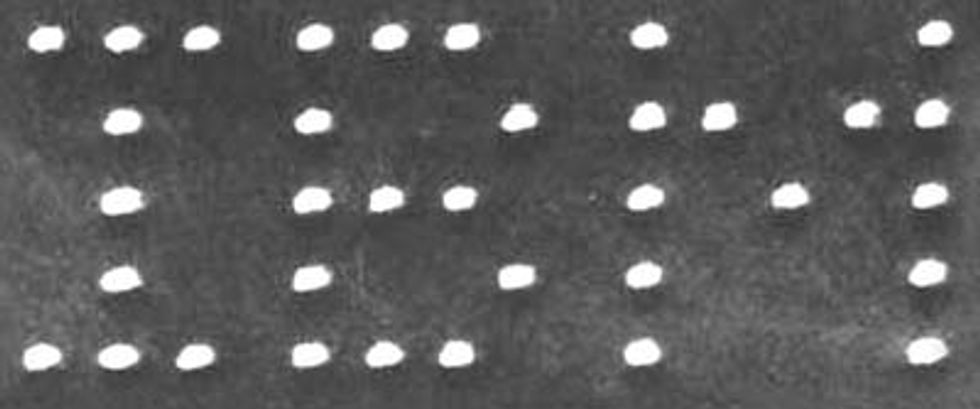
Among the people most impressed by “IBM” writ small was Nanochip founder and chief technology officer Tom Rust. If you could use probe tips to create orderly patterns on surfaces, he reasoned, it followed that you could use those same STM probes to write and read data. “I saw what IBM had done with a scanning tunneling microscope and spelling out ‘I-B-M,’” he says, “and that inspired me to use probes to build a disk drive.”
It was 1991, and Rust, an engineer who had spent most of his career working on hardware and software for displays, had just devoured K. Eric Drexler’s nanotech manifesto Engines of Creation (Anchor Press/Doubleday, 1986). He was looking for a way to engineer Drexler’s ideas into products when IBM, his future rival, provided the answer. Though he had no experience with nanotechnology, he plunged into it with the fervor of a true believer.
Rust’s divergent career had begun in 1975, when, as an undergraduate computer science major at the University of Illinois at Urbana-Champaign, he took on a consulting gig for Magnavox Co. to build one of the first graphic cathode-ray-tube displays. He soon dropped out of college to create arcade video games and eventually went on to run a series of small businesses that produced 3-D solid modeling and animation hardware and software. This phase of his career culminated in a commission from the government of Singapore in 1990 to build a $2 million laser-dappled musical water fountain that now gushes on Sentosa Island, off Singapore’s coast.
Then, infected by Drexler’s visions of nanomechanical assemblers that could fabricate any kind of material or machine from the atoms up, he “caught the nanotechnology bug” and holed up for several weeks in the library stacks at the University of California, Berkeley, and Stanford University doing what he had done his whole life—teaching himself something new. He quickly concluded that he would have to use some sort of MEMS-based device as a platform for his STM probe, so he delved into technical journals to learn MEMS design and manufacturing.
After hearing that Lawrence Livermore National Laboratory, in California, had an STM, Rust contacted the lab and learned of a U.S. Department of Energy program that provided $5000 grants to small businesses so they could access lab facilities and services. Rust applied, and soon he found himself at Livermore developing a write-once medium on which an STM could make 30-nm diameter “donuts,” his first nanobits. For that he and Joanne Culver, his research partner and wife, were awarded U.S. Patent No. 5453970, but further investigation and extensive reading quickly led him to shift from his original STM concept to another technology invented by Binnig at IBM, the atomic force microscope.
Both map the topography of the surface of a material using a sharp-tipped cantilever, but in contrast to the STM, the AFM maps the surface of a material with laser light. As the probe scans the sample surface, the electron clouds orbiting the atoms at the tip bump the ones orbiting the atoms on the sample’s surface, ever so slightly deflecting the cantilever. A photodetector records the laser light reflected off the cantilever, providing the data necessary to determine the amount of deflection, and to create a 3-D image of the surface topology.
While intrigued with the idea of using an AFM tip in direct contact with a surface to read and write bits, Rust knew that the speed of the tip skimming over a spinning disk would quickly grind the tip down. So he designed a MEMS device that would hold the tip and help it nimbly skip over the rotating platter, touching down only where it needed to write a bit, until it ran out of travel. Then the MEMS platform would hop backward over the medium, not unlike the automated stylus arm on a turntable, which at the end of a record picks up and moves back to the starting position.
“One day I was looking at the complexity of this and thought, well, this is crazy!” says Rust with a chuckle. Instead of skip-hopping heads over a spinning disk, he figured he could have the MEMS platform move up and down and side to side over a stationary storage material, radically cutting down on component complexity and power consumption. The Nanochip was born.
Rust built the first MEMS devices in 1994 with a 0.8-micrometer process traditionally used for making chips. He designed and built four platforms per die, with eight cantilevers on each, along with some electronic controls. It was, he admits, a dismal failure that taught him a lot about MEMS and chip design and fabrication, including the fact that the Nanochip (or IBM’s Millipede for that matter) doesn’t need to be made by the world’s most advanced 90-nm chip fabrication process. An old 1-mm fab is perfectly capable of making MEMS scanners and AFM tip arrays, a major reason that researchers are confident they’ll be able to fabricate probe drives cheaply.
For the next two years, Rust shuttled across San Francisco Bay between his house in Oakland and the Stanford campus, where he paid to use MEMS fabrication equipment to prototype his designs and tweak the fabrication process. By 1996, he had made enough progress to impress his deep-pocketed friend Jerry Fiddler, founder of Wind River Systems Inc., a software company in Alameda, Calif. With Fiddler’s backing, Rust phased out his computer graphics business and incorporated his new endeavor as Nanochip.
The notion of using the AFM not only to characterize a surface but also to manipulate materials at the atomic scale—the foundation of probe storage—was a serendipitous byproduct of the AFM’s development, Binnig says. “We always made mistakes and then you produced a little indentation in the samples. So the manipulation was always a side effect, and in the early days it was clear this would also be important.”
In the early 1990s, a researcher at IBM’s Almaden Research Center, Dan Rugar, used an AFM probe to write and read bits. Like Rust, Rugar initially used a spinning disk. In Rugar’s setup, a laser heated the probe tip, which in turn pressed into a rotating polycarbonate disk, softening it and creating a shallow pit representing a bit, in this case a 1. Rugar’s prototype stored 30 Gb/in2, but there was no way to erase and rewrite data.
And there was no readily apparent way around the potential showstopper, the slow data rate of a single mechanical AFM probe tip, which takes about a microsecond to write or read a bit, something flash memories and hard disk drives do in a nanosecond.
Rust used a few probes operating in parallel to increase the data rate. Binnig thought bigger. “Why not have thousands of cantilevers working in parallel?” he recalls asking colleagues around 1994. “If you have a thousand probes, you’re a thousand times faster on a chip that is three by three millimeters, and you’re competitive with flash” and its 2- to 10-megabytes-per-second data rate.
Market competitiveness wasn’t on the agenda when Binnig and his colleague Peter Vettiger first kicked around ideas like this when they played for the ZRL soccer team in the late 1970s. After games they would often grab a beer in a nearby pub. Their conversations inevitably came around to the same idea: the fabrication and operation of large-scale micro- and nanomechanical devices on a single chip.
Those ideas sat in cold storage during the 1980s, while Binnig invented the AFM, spent time in the United States, and eventually started up the IBM physics group at the University of Munich, in Germany. It wasn’t until Binnig returned to Zurich in 1994 that he and Vettiger got serious about turning their nano musings into a real device. Soon after Binnig’s arrival, fellow footballer and Nobel laureate Rohrer organized the first of many brainstorming sessions that focused on creating large AFM probe arrays on a single silicon chip for highly parallel and ultradense data storage.
IBM had just sold off its laser unit, for which Vettiger, an IEEE Fellow, had been in charge of technology research. Keenly aware that IBM was in the throes of a major change, he and Binnig understood that they needed to focus on research projects with a near-future payoff. They decided to pool their talents and the resources of the science and technology and the systems departments at ZRL. They officially established the Millipede project in 1996, the same year that Rust incorporated Nanochip. The race was on.
In the 1990s, IBM, which pioneered the modern hard disk drive with the 3340 “Winchester” in 1973, was a major player in data-storage hardware. But for the 21st-century company, Millipede is a throwback. With the acquisition of PricewaterhouseCoopers and the sale of its hard drive business to Hitachi, both in 2002, Big Blue is focusing on software and services. Nowadays, it routinely pairs researchers with consultants to reengineer the guts of a corporate computer system or to make a supply chain more efficient. The Millipede work, however, brings glimpses of the old IBM research system, where researchers published profusely and left hardly any ramification of an invention unexplored.
In stark contrast, Nanochip has maintained a much lower profile, quietly pumping out only enough patent applications and prototypes to entice investors, technology partners, and potential customers. The Nanochip architecture is designed in-house. Everything else is contracted out: the fabrication, the storage media, the control and interface electronics, the error-correction codes, and the packaging. This strategy, company executives insist, will allow Nanochip to quickly mix and match components to meet the needs of a smart-phone maker one day and a digital-camcorder company the next.
Such a low-overhead business model is the difference between a fabless, VC-funded start-up that must produce a fast return on investment and a research program that will go on regardless of the product’s ultimate commercial fate, according to Evangelos Eleftheriou, the Millipede project comanager. Eleftheriou, an IEEE Fellow, says that in theory finely controlled cantilever arrays can manipulate anything on the molecular and atomic scales, from engineering individual proteins to writing lines on a chip that are an order of magnitude thinner than today’s best optical lithography can produce.
By 1998, the millipede team had fashioned an array of 25 silicon cantilevers with aluminum heaters near the tips. The device could read bits but not write them. The team wanted to write a 1 by heating a cantilever tip and pressing it into the polymer medium to form a shallow pit. A zero would be easy—just leave the bit location untouched.
The inability of the 25-cantilever array to write 1s was caused by the passage through the cantilevers of high current, which forced the aluminum ions in the heaters to clump together, creating voids that inhibited the conduction needed to warm the tips. The answer here, the researchers found, was to make the heaters out of silicon too.
Another problem cropped up around the same time: the current needed to heat each probe tip could not be confined to a single cantilever. When current was sent to a cantilever, some leaked out. Eventually that leaked current accumulated and flowed all over the array, wreaking havoc with signals or causing short circuits. The uncontrolled flow of current would only get worse with more tips packed closer together, and the next milestone, a demonstration of a 1024-tip array, was coming up.
In solid-state memories, the flow of current is controlled by transistor switches, but the temperatures used to create the probe tips would destroy any transistors the Millipede team might try to integrate onto the cantilever.
Vettiger and colleague Michel Despont proposed that each Millipede cantilever have a Schottky diode, rather than a transistor, to restrict the current flow. Unlike a transistor, the diode could withstand the thermal processing necessary to create the adjacent tip. The metal-semiconductor-junction Schottky diode allows the current intended for its assigned cantilever to flow through it with almost no loss (Schottky diodes have especially low forward-voltage drop). The diode also blocks the flow of current in the reverse direction, sealing the cantilever off and keeping stray current from running amok on the device. In effect, the diodes allow cantilevers to be addressed individually for read, write, and erase functions.
After integrating the Schottky diodes, the team discovered that a curious thermal phenomenon gave them an unanticipated bonus. The tips scan over the medium to detect bits, interpreting pits as 1s and flat locations as zeroes. When a tip dips into a pit, the temperature, and therefore the cantilever’s electrical resistance, drops, reliably and very sensitively indicating a 1. When the tip scans a flat location, the temperature, and therefore the resistance, is unchanged, indicating a zero. The team had been using piezoresistive sensors at the base of each cantilever to convert the mechanical strain of a tip dipping into a pit into a change in resistance that could be read as a bit. With their new thermomechanical sensing mechanism in hand, the IBM researchers could dispense with the piezoresistive sensors.
In May 1998, equipped with the new silicon heaters and the integrated Schottky diodes, the team demonstrated an array of 1024 cantilevers that could read and write on a polymer surface. IBM, with Millipede, was out in front of the probe drive pack, followed by a team at Carnegie Mellon University, in Pittsburgh, and Hewlett-Packard Co., in Palo Alto, Calif., which eventually abandoned its program.
Meanwhile, back in California, Silicon Valley was erupting with the irrational exuberance of the dot-com bonanza. Although Rust now had three employees, he was doing most of the design, layout, mechanical work, and simulations of the Nanochip himself. He had just completed the first prototype that successfully integrated cantilevers, tips, and a moving platform, and was about to test it with the charge-based storage medium he was using at the time, when personal tragedy struck.
In August 1999, Rust’s wife, Joanne, who at the time was helping Rust manage Nanochip Inc., died of breast cancer. Some people might have found solace in religion or alcohol. Rust glommed onto the Nanochip.
“After my wife died, I realized that I could make a contribution by developing something that could hopefully benefit everybody in some large-scale way,” he says. “Money was never an objective for me. I was doing this with a larger scheme of things in mind.”
Going back to work a few months after his wife passed away, Rust was determined to commercialize the technology. So he hired a new management team to guide the business through its next phase. Then, just as Rust was getting back into a working groove, corporate skullduggery almost torpedoed Nanochip altogether.
The company had linked up with an investor that gave the company enough working capital for it to continue development on a limited scale and to engage an outside contractor to make a controller for the Nanochip (an effort that ultimately failed).
Around the same time, for reasons Nanochip’s current executives are legally barred from discussing, the company’s cash suddenly evaporated, leaving Rust alone and deep in the red.
Despite the bleak circumstances, Rust clung to the notion that the Nanochip had a commercial future and decided to put together yet another management team. “I’d watched over the years the enormous growth in the uses of atomic probes for so many different analytical applications,” says Rust. “That in itself kept me believing that the technology would get there.”
Within a few months of Nanochip’s near collapse, Rust met Gordon Knight, who, like many Silicon Valley executives in 2002, was looking for a job after the dot-com implosion. Knight, founder of three optical disc storage companies and former CEO at Maxoptix Corp., in Louisville, Colo., was willing to work for Nanochip without pay until he could find some funding. He quickly orchestrated a deal with a Malaysian concern, AKN Technology Bhd, in Penang, which came through with $1.8 million, enough for Rust and Nanochip to pay off some debts and produce a prototype.
By the time the company showed the prototype to potential second-round investors last year, it had gone through as many changes as Rust had.
Even as his company was fighting for survival in 2000, Rust was in the lab, reengineering the Nanochip. In contrast to Millipede, where the storage medium sits on a MEMS platform that moves in relation to a stationary array of probe tips, the Nanochip’s probe-tip arrays are on platforms that move in the x and y directions in relation to a stationary storage medium. Whereas Millipede’s probe tips use electrostatic forces to move up and down on the z-axis, bringing them into contact with the medium, as late as 2000, Rust was controlling each cantilever with an actuator that vibrated each tip up and down the z-axis, to put the tips in contact with the medium. A piezoresistive sensor attached to each cantilever sensed the tip’s position on the z-axis, information that was fed to the external controller to tell it where the tip was in the read/write process.
Like Rust’s original rotating-disk storage device, the mechanism was too complex to be made commercially. He decided to get rid of the sensors and vibrating actuator. Instead he chose passive cantilevers that are spring-loaded against the storage medium at all times, with an electrical connection to facilitate heating and bit sensing.
Then Rust spotted another opportunity for simplification. At the time, the charge-based media he was using required a capacitance sensor and some accompanying electronics. By switching to media that had a much larger signal output, Rust could dump those components, slashing 30 to 40 percent from the manufacturing cost.
It’s the kind of challenge that IBM would handle by throwing together a team of the world’s foremost materials scientists and industrial physicists and giving them orders to invent a new miracle material. But Rust had to find something “off the shelf,” which he did at Ovonyx Inc., in Sunnyvale, Calif. The company sells a storage material made of germanium-antimony-tellurium (GeSbTe), or GST, a member of a class of substances called chalcogenides. It’s used in rewritable CDs and DVDs and is even the basis of yet another flash competitor, the Ovonic Unified Memory, which Ovonyx is developing with Intel, STMicroelectronics, and BAE Systems.
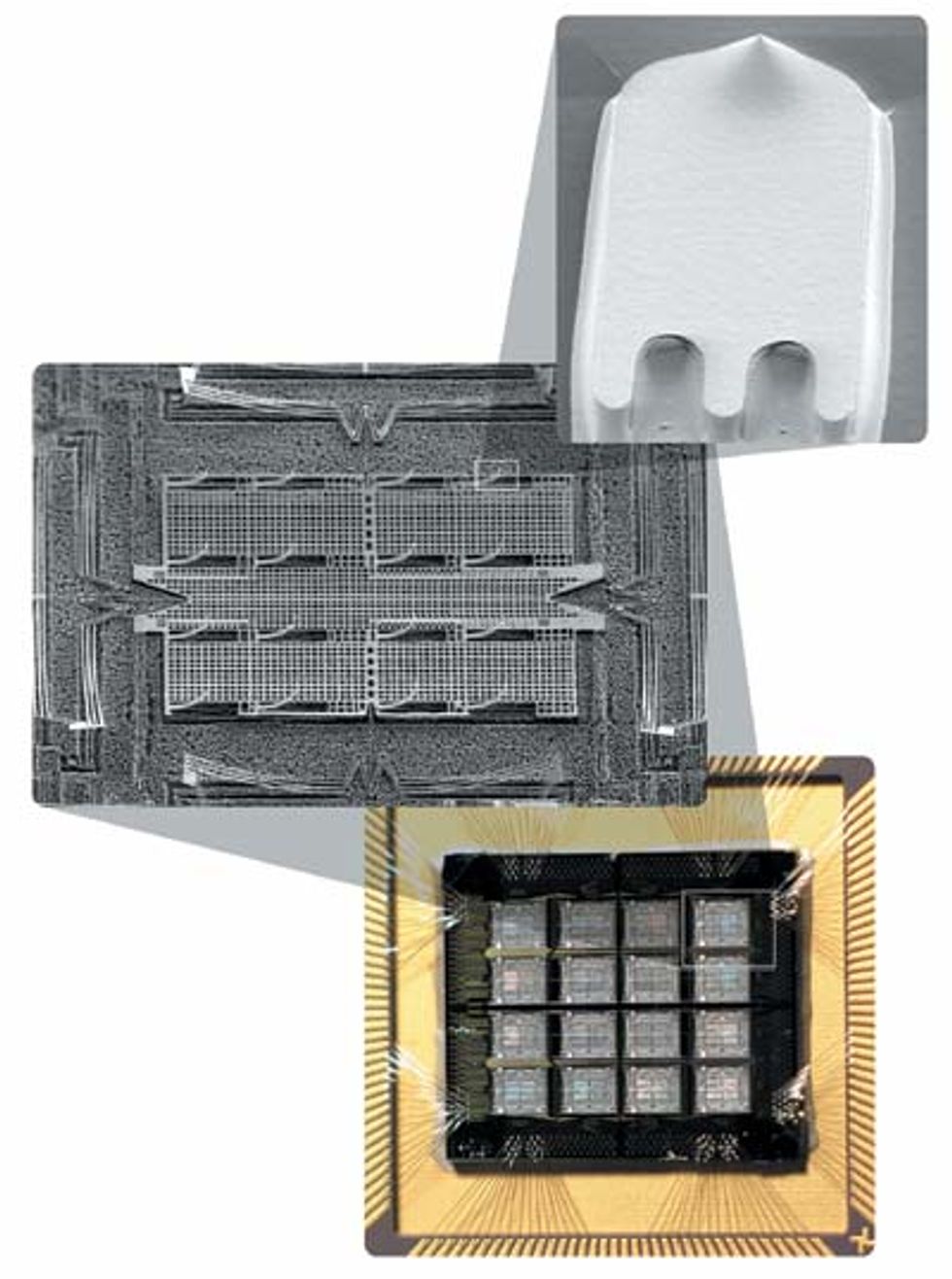
When heated by an AFM probe tip, the GST material quickly switches between stable amorphous and crystalline phases. The two states have very different electrical resistances: amorphous is high, crystalline is low. To write data, the tip heats the chalcogenide past its melting point; when the substance is quenched—think hot steel plunged into cold water—the heated region is in an amorphous state. To make it crystalline again, the tip heats the region to just below the melting point for a few nanoseconds to allow the atoms to form crystalline structures. To read data, the probe detects whether the resistance is high—a 1 at a crystalline bit space—or low—a zero at an amorphous one.
“We discovered that we could produce incredibly tiny bits, much smaller than what we had ever thought we could do,” says Rust, of those heady days in early 2003. “We had been planning on 25- to 40-nm-diameter bits, and we were right off the bat doing bits that were as small as 10 or 15 nm across.”
On 21 May 2003, Rust and company tested the new prototype. After writing some bits on the GST media, they switched into read mode and had the device scan for data. “The data wasn’t always there,” Rust recalls. “But on several of the scans the data was clearly there, at the correct timing position.”
After seven more months of tweaking and testing, in February 2004, the GST-based Nanochip prototype impressed investors to the tune of more than $20 million in second-round funding from JK&B Capital, Microsoft, New Enterprise Associates, and Nanochip’s old benefactor, AKN [see photo, "The Nanochip"].
While nanochip was landing millions in funding, Gerd Binnig was putting on a little show in his office at ZRL. With a gleam in his eye, he produced a sponge and a golf ball and explained that a big challenge for Millipede is that the repeated heating and scraping of the tips against the media could wear out both at an unacceptable rate. Binnig had been working on the problem in his kitchen late one recent evening. He had been contemplating a ruined roasting pan, a casualty of his quest for a simple way to model the storage media half of that interaction. Undaunted by his past failures or the prospect of spousal wrath, he took another pan, shaved some candles down to their wicks, and put the collected wax in the oven to melt. Then Binnig dunked a sponge in the hot liquid and let it cool and harden. Binnig pressed a golf ball into the wax-soaked sponge, put a weight on top of it, and waited. The ultimate rewritable medium had just recorded its first bit.
“I took the ball out when it was cooled down, and there was this nice indentation,” he recalls. “And when I raised the ball off the sponge and heated the sponge up again, the indentation popped up. The springiness of the sponge takes care that it always comes up, and the viscosity of the wax lets you switch back and forth from liquid to solid, depending on temperature.”
Thus, in IBM’s current probe-storage system, the AFM tips act as nano-golf balls. They record, read, and erase bits on a medium—which corresponds to the waxy sponge. In the IBM system, the medium is actually a heavily cross-linked polymer, in which long stringy molecules are linked together by chemical chains to form a single giant molecule.
To write a 1, the cantilevers designated to write a bit are heated to 400 °C using resistive heaters integrated next to the tips. Simultaneously, a voltage is applied to a capacitive platform that sits between the two prongs of each wishbone-shaped cantilever, creating an electrostatic force that bends the cantilevers up and brings the tips into contact with the polymer. The hot tips press into the polymer and soften it, forming pits that measure a few nanometers in depth and 10 to 15 nm in diameter and are linearly spaced at 20-nm intervals.
To read data, a second resistive heater next to each tip is heated to about 200 °C. When a tip moves into a pit, the cantilever and heater come closer to the polymer substrate, which cools the heater more efficiently. As a result, the heater’s resistance changes, and this change is detected by readout electronics. Because cooling is more efficient when the tip is in a pit, a 1 is detected as a decrease in resistance resulting from a decrease in temperature. But since the temperature differences, and therefore the resistance changes, are infinitesimal, data are processed by advanced error-correction codes before they are written and after they are read.
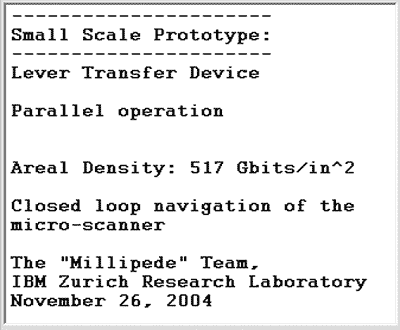
There are two ways to erase data. One involves placing a 400 °C tip in a pit and heating it until the polymer springs up, as Binnig’s model showed; the other requires a hot tip to press into the polymer near a pit, forming a new bit and in the process filling in, and erasing, the neighboring pit.
The storage media, along with the rest of the Millipede device, passed its first comprehensive test in a small-scale prototype demonstration held this past November. The critical components—the probe array, microscanner for moving the storage medium, servomechanism, analog electronics, detection circuitry, digital signal processor, and error-correction codes—all worked together to achieve an important milestone: the successful storage and retrieval of a text message at an areal density of 517 Gb/in2. Not only did the assembly work as promised, but the whole control process worked, too [see photo and diagrams, "The Millipede"].
Though clearly pleased with the success of the Millipede demonstration, held in front of IBM brass, project managers Johannes Windeln and Eleftheriou aren’t satisfied. “This isn’t over. This is a small demonstrator, and there are many issues that we have to work on,” Eleftheriou said afterward in a phone interview. Chief among them is improving the control of the MEMS microscanner to subnanometer precision, so that it can clearly and reliably write at areal densities as high as 1 Tb/in2. To compete with flash, the team also has to make tradeoffs among parameters such as the number of tips in a system, power consumption, and read- and write-data rates.
So what’s next? “This is a research group, not a development laboratory,” Eleftheriou replies when asked about Millipede’s next milestone. “It is our job in research to understand a new technology and bring it to a point where a development group can make a product out of it.”
Manufacturability will determine whether or not consumers will ever slot Millipede or Nanochip memories into their media players or camcorders. According to Marlene Bourne, a MEMS analyst at In-Stat, Scottsdale, Ariz., manufacturability hinges on component complexity. “While the Nanochip is very similar to the Millipede, it doesn’t have as complex an array of tips,” she says. “I think they’re quite a ways down in terms of complexity.”
Bourne knows the basic concept behind the Nanochip but not much more, which is just the way Nanochip likes it.
“Our investors are pretty edgy about us talking,” says Nanochip CEO Knight. “There’s no point in advance publicity, and then if you’re late, everybody starts throwing stones at you.” Though he cautions that the company still has a lot to do before it samples beta units, Knight says he’s confident the Nanochip will be on the market within two years.
Bourne is more skeptical about the near-term prospects for probe storage, but she is convinced it will ultimately emerge, perhaps five or six years from now, as a strong competitor to flash. “Unfortunately, the time to market for most MEMS devices is a lot longer than people would like,” she says. “I have no doubt that at some point there will be a MEMS rival to flash memory on the market—if not these two specific architectures, then something very similar. It’s just a question of when.”
It is also still a question of who. Seagate Technology LLC, in Scotts Valley, Calif., has an active probe-storage program based on technology developed at Carnegie Mellon. But there’s also Samsung Group, in Seoul, South Korea, the world’s top manufacturer of DRAM chips, which has been presenting papers recently on its probe-storage research. And Samsung holds the most recently granted U.S. patent for a probe drive, No. 6762402, issued on 13 July 2004, which if nothing else indicates that the race to the bottom is still wide open.
To Probe Further
Gerd Binnig and his colleagues described the Millipede system in great technical detail in “The ‘Millipede’—Nanotechnology Entering Data Storage,” by P. Vettiger et al., IEEE Transactions on Nanotechnology, March 2002.
You can follow Tom Rust and Nanochip’s progress at https://www.nanochip.com.
